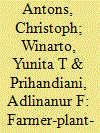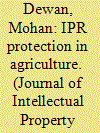|
|
|
Sort Order |
|
|
|
Items / Page
|
|
|
|
|
|
|
| Srl | Item |
| 1 |
ID:
086956


|
|
|
|
|
| Publication |
2009.
|
| Summary/Abstract |
The application of intellectual property rights (IP) in developing countries is and remains highly controversial, particularly as regards applications to food/agriculture, and pharmaceuticals, which have direct ramifications for large numbers of peoples. One dimension complicating a reasoned dialogue on the public benefits of IP, particularly when many developing countries are implementing the Agreement on Trade-Related Aspects of Intellectual Property Rights (TRIPS) as mandated by membership in the World Trade Organization, is a dearth of information on their actual operation and effects. In this study, we address one particular aspect of the limited documentation on the effects of IP systems, the effect of plant variety protection (PVP) on the genetic productivity potential of varieties. Specifically, we examine wheat varieties in Washington State, United States, which are produced by both public and private sector breeders. Results from the study show that implementation of PVP attracted private investment in open pollinated crops such as wheat in the United States and provided greater numbers of varieties of these crops, which are high yielding from both the public and private sectors. These results may provide some insights for policy makers from developing countries on the effects of IP for plants as their TRIPS commitments are being implemented.
|
|
|
|
|
|
|
|
|
|
|
|
|
|
|
|
| 2 |
ID:
105122


|
|
|
|
|
| Publication |
2011.
|
| Summary/Abstract |
The UPOV Convention was adopted in 1961, and it entered into force in 1968. The Convention aims at encouraging innovation in the field of plant breeding. It provides a legal framework and system of implementation of plant variety protection and is the only internationally harmonized, effective sui generis system of plant variety protection. The UPOV Convention was amended in 1972, 1978 and 1991. UPOV had 68 members as on 4 November 2010, and the numbers continue to expand. The impact study carried out by an ad hoc working group, and published by UPOV has shown the benefits of an effective sui generis system of plant variety protection.
|
|
|
|
|
|
|
|
|
|
|
|
|
|
|
|
| 3 |
ID:
175480


|
|
|
|
|
| Summary/Abstract |
In the last two decades, some Javanese rice farmers have learned to be plant breeders with the help of Farmer Field Schools for Participatory Plant Breeding. However, they have experienced problems with seed and intellectual property laws primarily focused on the strengthening of the seed industry and compliance with development plans. A number of farmers have been prosecuted for experimenting with seeds, prompting a partly successful challenge to relevant provisions in Indonesia’s Constitutional Court. Subsequent legislative changes have restored some farmers’ rights, but also brought new reporting requirements and limitations. Using James Scott’s concept of “transformative state simplifications,” this article shows that legal challenges to regulations are just one strategy of self-help. The political reform process and possibility for constitutional challenges have opened up space for debates about how farmers can benefit from laws that seek to regulate their cultivars. The United Nations Declaration on the Rights of Peasants and other developments are likely to intensify discussions about what precisely various laws mean by their encouragement of “small farmer varieties,” “food sovereignty,” and a “sustainable agricultural cultivation system.”
|
|
|
|
|
|
|
|
|
|
|
|
|
|
|
|
| 4 |
ID:
105125


|
|
|
|
|
| Publication |
2011.
|
| Summary/Abstract |
The Indian Protection of Plant Varieties and Farmers' Rights (PPV&FR) Act is now a decade old and PPV&FR implementation implications are now clearly visible. The shortcomings and inadequacies in implementation of the Act and the Rules are a matter of grave concern to the seed industry, in particular, and Indian agriculture, in general. This needs to be addressed and resolved by the Central Government and the PPV&FR Authority in order to meet the objectives enshrined in the Act. These inadequacies are perceived in terms of slow-moving approach for database maintenance of existing varieties, notification of crop species eligible for registration, duration and effect of registration of extant notified varieties and varieties of common knowledge, ambiguity in parent line and hybrid registration under new variety and/or extant variety category, powers of the Registrar, advertisements published in Plant Variety journals, registration of transgenic varieties, parent lines etc. This paper highlights the issues that need to be resolved to avoid misuse of the Act and thereby unwarranted litigations.
|
|
|
|
|
|
|
|
|
|
|
|
|
|
|
|
| 5 |
ID:
105123


|
|
|
|
|
| Publication |
2011.
|
| Summary/Abstract |
The United States offers several ways for plant breeders to protect their inventions; plant patents, utility patents, or plant variety protection. There are differences in the type of material that can be protected under each system and the criteria used to examine the application. There is often confusion among applicants regarding why the United States has so many choices, which choice or choices apply to their situation, how to file an application and how that application will be examined. This article provides a basic overview of plant patents, utility patents and plant variety protection in the US.
|
|
|
|
|
|
|
|
|
|
|
|
|
|
|
|
| 6 |
ID:
105129


|
|
|
|
|
| Publication |
2011.
|
| Summary/Abstract |
Private rights in living objects have always been controversial. Agriculture provided the first wave in human civilization. Therefore, agriculture including plant breeding and agricultural methods pre-dated any form of IPR protection unlike industry and commerce. Traditionally, IPR was not applied to agriculture. In recent times, this position has changed and increasingly agriculture is seen as an industry that cannot survive without research and development and astute investments. This has made it necessary that IPR in all its forms be extended to agriculture.
|
|
|
|
|
|
|
|
|
|
|
|
|
|
|
|
| 7 |
ID:
105136


|
|
|
|
|
| Publication |
2011.
|
| Summary/Abstract |
One essential function of a technology transfer office is the proactive management of intellectual property related to crops and germplasm. Most of the agriculture stations and universities over the world have established technology transfer offices to protect their own plant varieties all over the world. This paper focuses on the patent policies, technology transfer policies and special practices within the office of technology commercialization at the University of California, which, by some measures, is the largest public technology transfer program in the world
|
|
|
|
|
|
|
|
|
|
|
|
|
|
|
|
| 8 |
ID:
087688


|
|
|
|
|
| Publication |
2009.
|
| Summary/Abstract |
The Agreement on Trade-Related Aspects of Intellectual Property Rights of the World Trade Organization imposes an obligation on all member countries to protect plant varieties either by patents or by a sui generis regime or by a combination of both. India explored the sui generis option to provide protection to plant varieties. This legal regime recognizes the rights of commercial breeders and also grants a positive right to farmers and goes beyond the widely recognized international sui generis regime represented by the International Union for the Protection of Plant Varieties (UPOV). Notwithstanding this, India has made an application to join UPOV. However, with the present plant variety law, India's membership application to join UPOV may not be successful. The recent development of bringing the Seeds Bill, which dilutes farmers' rights provisions in the plant variety law, is important in this regard. The article argues that if the Seeds Bill is passed in its present form, it will dilute the beneficial provisions of the plant variety law and pave the way for India to join UPOV.
|
|
|
|
|
|
|
|
|
|
|
|
|
|
|
|
|
|
|
|
|